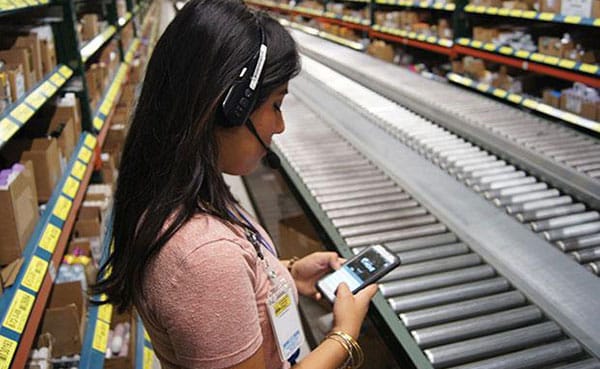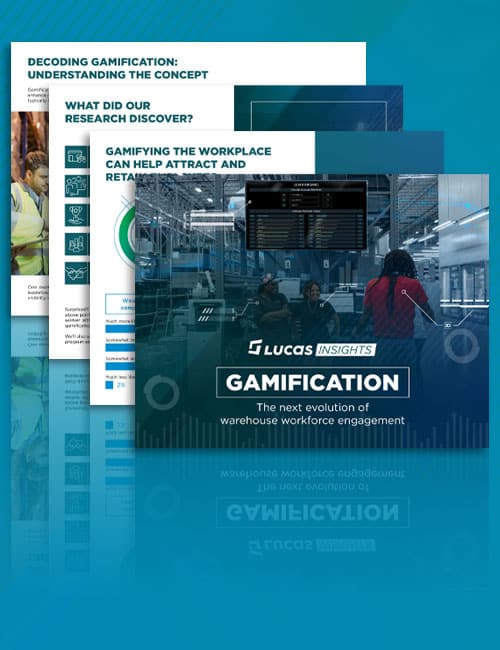 By Ben Smeland, Senior Software Engineer, Lucas Systems
By Ben Smeland, Senior Software Engineer, Lucas Systems
The optimization of warehouse fulfillment and shipping is challenging. Difficulties include workforce training, language barriers, accuracy, and speed. Warehouse picking technology can overcome these challenges, reducing downtime, improving efficiency, and raising profit margins. There are a lot of technologies to choose from, depending on your level of automation maturity. Let’s take a look at some solutions along the maturity ladder.
Basic Warehouse Management Systems
Starting with the basic WMS-only solution, picking is done by paper, with each individual taking a pick sheet to get the items for a given order or set of demands. In Lucas Systems’ recent Voice of the Warehouse Worker Insights survey, more than 66% of our respondents said that picking, packing, and other warehouse processes at their places of employment are still done this way. This demonstrates that many warehouse and DC operators are still in the early stages of understanding the potential of this technology. There are several negatives to this stage.
First, training takes time, as operators need to understand where and what things are to be accurate. There is no picking validation, and to be sure, an auditor would have to review picks, which is another employee needed. Language barriers can make picking by paper even more difficult. Despite any downside, all picking has to start somewhere, and this solution is the easiest to get in place, with the high cost being paper.
For example, one Lucas food service customer’s previous picking and loading processes were directed by paper using printed rack sheets from their ERP system. While the system worked reasonably well for them, the paper-based processes created challenges for pickers, managers, and delivery drivers. Managers had to print, sort, and distribute over 2,000 sheets of paper daily, taking them away from managing work on the warehouse floor.
Introducing Tablets and Scanners
Picking up the tempo a bit, a unified hardware system could take the picking from a walk to a bike ride. Tablets or handheld devices that replace paper overcome some of the previous challenges. Language packages can overcome the language barrier. The inclusion of scanners can provide real-time accuracy and boost productivity. With connected devices, management can glean real-time statistics and plan the workforce. Of course, the depth of the system’s capabilities could allow for more, such as pathfinding, slotting, and even gamification.
The downside to this system is the hand stack. A given user only has so many hands; when carrying devices, picking up items, scanning, and others, you eventually have to start juggling things. This burden can be handled with mounted devices where applicable. Before using Jennifer, Lucas Systems’ voice-directed application, one customer said the performance could have improved the slow pace of handling paperwork and the lack of a hands-free environment. “You’re opening cartons, handling books, putting them into those cartons, combining them into trains. We knew we needed a hands-free solution,” said their director of fulfillment.
Evolving Warehouse Management Software
This is where voice picking systems come in to overcome the hand-stack limitation. To keep the analogy going, this takes that bike ride to a car ride. A headset in the unified device system frees up a user’s hands for the work. Now, users can listen while using their hands, speaking commands and hearing results without requiring hands, and, perhaps most importantly, not needing to have their eyes distracted by a screen.
Jennifer’s feedback on the Lucas voice system has helped users “keep their head in the game” or, using another sports analogy, “get in the zone.” They can watch what they are doing and not staring at a screen. Distracted drivers are a hazard, but so are distracted pedestrians. A solid voice solution gives all the benefits of the integrated system but removes the barriers and makes the procedure much easier for the end user. The same Lucas customer mentioned above felt much more prepared to compete in a digital e-commerce world after implementing the Jennifer system, boosting order fulfillment by 15%, increasing order accuracy by 5%, and reducing labor costs by 10%.
Improved Customer Experience With Augmented Reality
Where do you go next if voice systems cover all angles? Augmented reality (AR) would be the next evolution. The current negative to this is that it is a new industry that results in it being a bit cost prohibitive, but it can take that car’s speed and move it up to a plane’s speed. AR and voice incorporated could provide written text and speech in parallel, ensuring nothing is lost while overcoming the language barrier. On top of that, the inclusion of known technologies, such as Google translate, could overcome language barriers on signs and labels in the warehouse. Our partners at Zebra have developed augmented reality-enabled enterprise mobile computers to help to increase worker efficiency and accuracy.
Training could be dramatically reduced by having a heads-up display training pickers. Pathfinding could give users trails to follow to maximize their pick-to-distance ratio. Another benefit would be scan-by-sight, allowing a user or auditor to look at a bar code merely, optionally say a trigger word, and scan something into the system, eliminating scanner hand-use. And on a fun level, this could take gamification of the job to a new level, potentially boosting employee retention and general quality of life.
Where Does Robotics Fit?
The final technology to consider would be robotics. After all, if the warehouse picks itself with perfect accuracy, you can’t beat that. However, there will always be some challenges that require human intervention, so we cannot rule out the above technologies completely. Currently, many DCs are finding success in alleviating labor challenges using robots in multiple workflows, maximizing productivity by dynamically allocating workers and robots, improving ergonomics, and eliminating workplace injuries with robotics.
Specifically, several robot-assisted processes that can be integrated with humans and optimization software include:
- Robot-to-goods picking
- Goods-to-person picking
- Follow-the-robot picking or replenishment
- Transit robots
- Full pallet moves
The addition of robotics can reduce ce workforce and boost speed and accuracy but has a high cost and challenges associated with getting started. Based on published reports, the cost per AMR is approximately $30,000, plus 20 percent annual maintenance. These costs do not include implementation costs for WMS integration, development, on-site testing and deployment, and training.
WMS Software Offers Comprehensive Benefits
From a walk to flying, technology can dramatically improve speed and accuracy, reduce training time and boost understandability for warehouse pickers. Management can benefit from everything, from seeing real-time metrics, using workforce planning, slotting, and even being able to track users and their travel patterns for safety.
With AR, a manager could even see real-time metrics on locations and users while walking the warehouse, keeping them informed on the fly. Robotics could also be incorporated, taking over routine actions and more uniform pick processes. Each upgrade in technology will eventually pay for itself through cost savings and improved output, so the only question remains: where does one choose to start?
About Lucas Systems, Inc.
Lucas Systems helps companies transform their distribution center operations and continuously adapt to changing market dynamics. We dramatically increase worker productivity, operational agility, and customer satisfaction.
Our solutions are built on 25+ years of deep process expertise. Our solutions feature JenniferTM, the brain, voice, and orchestration engine that drives performance improvement. Make the smartest moves at the lowest cost with Jennifer. For more information, visit www.lucasware.com.

About the Author
Ben Smeland is a Senior Software Developer with Lucas Systems, leveraging over 19 years of software development experience to challenge and innovate against software architectures to promote clarity, performance, and sustainability.
With experience as a full-stack developer, software architect, and project manager, Ben has served in almost every capacity in the software industry, engaging with internal teams and customers to bring inventive, sustainable solutions to complicated business problems.
Having earned a Bachelor of Science degree in Computer Science and a Master of Science in Computer Information Technology, Ben excels at critical, out-of-the-box thinking and solving complexity through simplicity.





